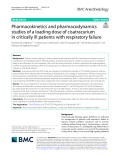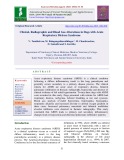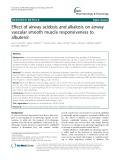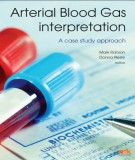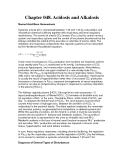
Respiratory alkalosis
-
Previous studies reported a slow neuromuscular response with the currently recommended dose of cisatracurium in critically ill patients. Pharmacokinetic and pharmacodynamic studies of cisatracurium in critically ill patients are still limited.
 10p
10p  viisaacnewton
viisaacnewton
 26-04-2022
26-04-2022
 11
11
 1
1
 Download
Download
-
This study concluded that ARDS leads to primary and secondary inflammatory changes leads to hypoxemia and abnormal pulmonary infiltrative patterns.
 6p
6p  trinhthamhodang11
trinhthamhodang11
 27-04-2021
27-04-2021
 11
11
 1
1
 Download
Download
-
(BQ) Continued part 1, part 2 of the document Interpretation about gas/acid-base in blood - Handbook (Second edition) has contents: Respiratory acidosis, respiratory alkalosis, metabolic acidosis, the analysis of blood gases, the analysis of blood gases, case examples,... and other contents. Invite you to refer.
 169p
169p  nanhankhuoctai7
nanhankhuoctai7
 01-07-2020
01-07-2020
 10
10
 1
1
 Download
Download
-
Effect of airway acidosis and alkalosis on airway vascular smooth muscle responsiveness to albuterol
In vitro and animal experiments have shown that the transport and signaling of β2-adrenergic agonists are pH-sensitive. Inhaled albuterol, a hydrophilic β2-adrenergic agonist, is widely used for the treatment of obstructive airway diseases.
 7p
7p  vienzym2711
vienzym2711
 03-04-2020
03-04-2020
 7
7
 1
1
 Download
Download
-
To investigate rate, characteristics of acid-base disturbances in patients with chronic kidney disease stage 4, 5 who were diagnosed for the first time. Subjects and methods: 182 patients with chronic kidney disease stage 4, 5 due to some causes without alkalization or replacement therapy within a month. Assessment of acid-base disturbances based on results of arterial blood gas test according to the criteria of Berend K, which include pH, HCO3 - and PaCO2.
 7p
7p  caygaolon
caygaolon
 01-11-2019
01-11-2019
 18
18
 0
0
 Download
Download
-
(BQ) Part 1 of the document A case study approach of the arterial blood gas interpretation has contents: Introduction to acid-base balance, a systematic approach to ABG interpretation, respiratory acidosis, respiratory alkalosis,.... and other contents. Invite you to refer.
 69p
69p  thuongdanguyetan05
thuongdanguyetan05
 05-07-2019
05-07-2019
 28
28
 2
2
 Download
Download
-
(BQ) Continued part 1, part 2 of the document Interpretation about gas/acid-base in blood - Handbook (Second edition) has contents: Respiratory acidosis, respiratory alkalosis, metabolic acidosis, the analysis of blood gases, the analysis of blood gases, case examples,... and other contents. Invite you to refer.
 160p
160p  thuongdanguyetan05
thuongdanguyetan05
 05-07-2019
05-07-2019
 11
11
 2
2
 Download
Download
-
(BQ) Continued part 1, part 2 of the document Clinical application in fluids and electrolytes (Eighth edition) has contents: Metabolic acidosis and alkalosis, respiratory acidosis and alkalosis, respiratory acidosis and alkalosis, fluid problems of the older adult,... and other contens. Invite you to refer.
 303p
303p  thuongdanguyetan06
thuongdanguyetan06
 06-06-2019
06-06-2019
 21
21
 3
3
 Download
Download
-
Normal Acid-Base Homeostasis Systemic arterial pH is maintained between 7.35 and 7.45 by extracellular and intracellular chemical buffering together with respiratory and renal regulatory mechanisms. The control of arterial CO2 tension (PaCO2) by the central nervous system and respiratory systems and the control of the plasma bicarbonate by the kidneys stabilize the arterial pH by excretion or retention of acid or alkali. The metabolic and respiratory components that regulate systemic pH are described by the Henderson-Hasselbalch equation: ...
 29p
29p  socolanong
socolanong
 25-04-2012
25-04-2012
 58
58
 4
4
 Download
Download
-
Chronic respiratory alkalosis is the most common acid-base disturbance in critically ill patients and, when severe, portends a poor prognosis. Many cardiopulmonary disorders manifest respiratory alkalosis in their early to intermediate stages, and the finding of normocapnia and hypoxemia in a patient with hyperventilation may herald the onset of rapid respiratory failure and should prompt an assessment to determine if the patient is becoming fatigued. Respiratory alkalosis is common during mechanical ventilation. The hyperventilation syndrome may be disabling.
 5p
5p  ongxaemnumber1
ongxaemnumber1
 29-11-2010
29-11-2010
 82
82
 4
4
 Download
Download
-
The clinical features vary according to the severity and duration of the respiratory acidosis, the underlying disease, and whether there is accompanying hypoxemia. A rapid increase in Pa CO2 may cause anxiety, dyspnea, confusion, psychosis, and hallucinations and may progress to coma. Lesser degrees of dysfunction in chronic hypercapnia include sleep disturbances, loss of memory, daytime somnolence, personality changes, impairment of coordination, and motor disturbances such as tremor, myoclonic jerks, and asterixis.
 5p
5p  ongxaemnumber1
ongxaemnumber1
 29-11-2010
29-11-2010
 104
104
 3
3
 Download
Download
-
Alcoholic Ketoacidosis: Treatment Extracellular fluid deficits almost always accompany AKA and should be repleted by IV administration of saline and glucose (5% dextrose in 0.9% NaCl). Hypophosphatemia, hypokalemia, and hypomagnesemia may coexist and should be corrected. Hypophosphatemia usually emerges 12–24 h after admission, may be exacerbated by glucose infusion, and, if severe, may induce rhabdomyolysis. Upper gastrointestinal hemorrhage, pancreatitis, and pneumonia may accompany this disorder. Drug- and Toxin-Induced Acidosis Salicylates (See also Chap.
 5p
5p  ongxaemnumber1
ongxaemnumber1
 29-11-2010
29-11-2010
 72
72
 2
2
 Download
Download
-
Metabolic Acidosis Metabolic acidosis can occur because of an increase in endogenous acid production (such as lactate and ketoacids), loss of bicarbonate (as in diarrhea), or accumulation of endogenous acids (as in renal failure). Metabolic acidosis has profound effects on the respiratory, cardiac, and nervous systems. The fall in blood pH is accompanied by a characteristic increase in ventilation, especially the tidal volume (Kussmaul respiration). Intrinsic cardiac contractility may be depressed, but inotropic function can be normal because of catecholamine release.
 5p
5p  ongxaemnumber1
ongxaemnumber1
 29-11-2010
29-11-2010
 70
70
 3
3
 Download
Download
-
Approach to the Patient: Acid-Base Disorders A stepwise approach to the diagnosis of acid-base disorders follows (Table 48-3). Care should be taken when measuring blood gases to obtain the arterial blood sample without using excessive heparin. Blood for electrolytes and arterial blood gases should be drawn simultaneously prior to therapy, since an increase in [HCO3–] occurs with metabolic alkalosis and respiratory acidosis. Conversely, a decrease in [HCO3–] occurs in metabolic acidosis and respiratory alkalosis.
 5p
5p  ongxaemnumber1
ongxaemnumber1
 29-11-2010
29-11-2010
 95
95
 4
4
 Download
Download
-
Figure 48-1 Acid-base nomogram. Shown are the 90% confidence limits (range of values) of the normal respiratory and metabolic compensations for primary acidbase disturbances. (From DuBose, used with permission.) Mixed Acid-Base Disorders Mixed acid-base disorders—defined as independently coexisting disorders, not merely compensatory responses—are often seen in patients in critical care units and can lead to dangerous extremes of pH (Table 48-2).
 6p
6p  ongxaemnumber1
ongxaemnumber1
 29-11-2010
29-11-2010
 73
73
 3
3
 Download
Download
-
Harrison's Internal Medicine Chapter 48. Acidosis and Alkalosis Normal Acid-Base Homeostasis Systemic arterial pH is maintained between 7.35 and 7.45 by extracellular and intracellular chemical buffering together with respiratory and renal regulatory mechanisms. The control of arterial CO2 tension (PaCO2) by the central nervous system and respiratory systems and the control of the plasma bicarbonate by the kidneys stabilize the arterial pH by excretion or retention of acid or alkali.
 5p
5p  ongxaemnumber1
ongxaemnumber1
 29-11-2010
29-11-2010
 87
87
 3
3
 Download
Download
-
Table 48-1 Prediction of Compensatory Responses on Simple AcidBase Disturbances and Pattern of Changes Range of Values Disorder Prediction Compensation of pH HCO3– PaCO2 Metabolic PaCO2= (1.5 x Low Low Low acidosis HCO3-) + 8 ± 2 or PaCO2 will 1.25 mmHg per mmol/L in [HCO3-] or PaCO2 = [HCO3] + 15 Metabolic alkalosis PaCO2 will 0.75 mmHg per mmol/L in [HCO3-] High High High or PaCO2 will 6 mmHg per 10 mmol/L in [HCO3-] or PaCO2= [HCO3-] + 15 Respiratory alkalosis High Low Low Acute 0.2 [HCO3-] mmol/L will per mmHg in PaCO2 Chronic 0.
 5p
5p  ongxaemnumber1
ongxaemnumber1
 29-11-2010
29-11-2010
 72
72
 3
3
 Download
Download
-
Extrarenal Nonrenal causes of hypovolemia include fluid loss from the gastrointestinal tract, skin, and respiratory system and third-space accumulations (burns, pancreatitis, peritonitis). Approximately 9 L of fluid enters the gastrointestinal tract daily, 2 L by ingestion and 7 L by secretion. Almost 98% of this volume is reabsorbed so that fecal fluid loss is only 100–200 mL/d. Impaired gastrointestinal reabsorption or enhanced secretion leads to volume depletion.
 5p
5p  ongxaemnumber1
ongxaemnumber1
 29-11-2010
29-11-2010
 68
68
 4
4
 Download
Download
-
Adaptation to Hypoxia An important component of the respiratory response to hypoxia originates in special chemosensitive cells in the carotid and aortic bodies and in the respiratory center in the brainstem. The stimulation of these cells by hypoxia increases ventilation, with a loss of CO2, and can lead to respiratory alkalosis. When combined with the metabolic acidosis resulting from the production of lactic acid, the serum bicarbonate level declines (Chap. 48).
 5p
5p  ongxaemnumber1
ongxaemnumber1
 29-11-2010
29-11-2010
 95
95
 3
3
 Download
Download
CHỦ ĐỀ BẠN MUỐN TÌM








